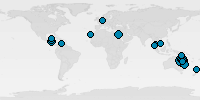
Byron Bay is a great scuba destination with whale watching, dolphin trips and breathtaking views across its spectacular bay and beaches.
| Inserted/Added by: | lars, © Author: Lars Hemel |
| Rated: | Rated 2.8, 21 votes |
Send us your images for this dive region[Add Image][Add Movie]
Byron Bay is one of the most popular holiday destinations on the East Coast of Australia. It was named in 1770 by Captain James Cook after John Byron, a great circumnavigator at that time. Byron Bay, part of Byron Shire, is a place where travelers around the world, backpackers and locals meet each other. Its international reputation comes from its secluded beaches, its beautiful hinterland and its great surfing and many surf breaks.
There are several walking trails through fantastic sub-tropical rainforests, white beaches, steep cliffs and tens of viewpoints across the spectacular bays and ocean. Arakwal National Park, Cape Byron Headland and the Broken Head Nature Reserves are some of the protected natural environments near Byron Bay. At Cape Byron, Australia's most eastern point, you can find the 22 meter high Cape Byron Lighthouse. Built next to sheer cliffs in 1901, the Cape Byron Lighthouse stands on a rocky headland and has served as a beacon for ships along this treacherous coastline. Besides Main Beach, many other beaches are popular. Between Broken Head and Lennox Heads you can find Seven Mile Beach, one of the largest in New South Wales. Other well known beaches are Watego's Beach, King's Beach, Broken Head Beach and Tallow Beach. There are also many festivals, resorts in all sorts and sizes, excellent Australian cuisine and evening entertainment in bars, pubs and clubs.
Its calm and tropical waters provide excellent conditions for several marine activities. There are many whale-watching trips and dolphin tours but also snorkeling and scuba diving is popular. You can visit spectacular dive sites such as the wreck at Main Beach or Three Sisters, slightly out of the bay. And at just a few minutes boat ride from Main Beach, you will find Julian Rocks, a small rock just a few kilometers offshore which is added to the Cape Byron Marine Park in 2002. Its marine and coral life is phenomenal with more than 400 different marine species cataloged. You can dive with sharks, whales, turtles and rays.
[Add Message]Messages from readers:
[Add Divelog]Divelogs from members:
